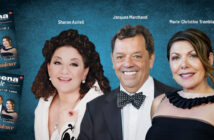
This page is also available in / Cette page est également disponible en:
Français (French)
When I became part of the Orchestre symphonique de Québec management team in 2009, I came up with the idea of implementing pre-concert musical talks at Grand Théâtre de Québec to share my passion for classical music. Conferences, hearings, and projections followed through partnerships with Quebec City’s Musée de la civilisation, Grande Bibliothèque Gabrielle-Roy, and Laval University. Nowadays, I share my musical passion through talks and hearings by way of large library and cultural centre networks, and other cultural organizations in Montreal, Trois-Rivières, and Quebec City. Finally, for the last 14 years, I have been happy to share my enthusiasm for classical music as host of a program on Montreal’s Radio Ville-Marie (91.3 FM).
I am not only passionate about discovering huge repertoire and great music but also passionate about sharing my research into therapeutic qualities of music and its attentive, active, and conscious listening with listeners. In a 1971 interview with John Roberts, great pianist Glenn Gould confided his conviction on “art’s therapeutic and restorative value.” In the same interview, Gould spoke highly about therapeutic qualities of listening to music calmly at home, in a space that fostered “a contemplative state.” During my conferences and musical talks, I attempt to take listeners away from the daily humdrum and have them listen to wonderful moments of music. I provide those present with a short moment of attentive and focused listening, coupled with an attitude that promotes contact with a deeply kind nature and inspired music.
When I started my career, I gave secondary importance to the quality of the equipment I used, since I thought that compressed music—often heard on mobile telephones in a distracted, noisy environment—went unnoticed. When I visited the Simaudio studios in Boucherville, however, my perception suddenly changed. A partnership with the company allowed me the use of one of its Moon audio amplifiers during my conferences. It is a misconception that this quality perception is reserved to beginners’ circles or to those used to hearing this type of audio refinement for many years. To my great surprise, many people in the audience talked about their joy of musical listening; most audience members appreciated the quality of this sophisticated equipment.
According to Ghyslaine Guertain, a philosophy professor at Collège Édouard-Montpetit, “Glenn Gould bestows a major technological role on ideal conditions to enable… the musical bliss that can only be possible in a closed space.” Gould believed that leading-edge technology was needed during music recordings to achieve the best music listening experience at home. Specialists, however, believe in the garbage-in, garbage-out theory. Regardless of the quality of hi-fi system used, recording quality is essential; it is wrong to think that sound coming out of compressions has no impact on recording quality. When all hi-fi system elements are taken care of, recordings are chosen, and listening conditions—home comfort, quiet, attentive listening—are the best, the experience is enhanced emotionally, physiologically, and spiritually. Dr. Daniel Levitin, neuroscientist at McGill University, confirms that brain regions stimulated by pleasant music listening are the same as regions stimulated by drug use or sexual intercourse. According to Dr. Levitin, music listening enables body dopamine, human and prolactin hormones, comfort hormones in breastfeeding mothers, and oxytocin, a confidence hormone, to secrete, all of this in direct association with sexuality and harmonious relationships with others. In the same vein of research, a study conducted by the Montreal Neurological Institute and Hospital and McGill University concluded that “music not only produced a sense of pleasure… but simply put, music is a special fuel that stimulates millions of brain nerve fibres that would otherwise remain dormant and underdeveloped… During moments of musical exhilaration, blood travels through the brain to locations where, like sex, chocolate, and champagne, it provides satisfaction and joy, and withdraws from brain cells linked to depression and fear.”
Physician David Bohm, a student of Einstein, showed in Patrice Van Eersel’s La source noire that there exists an order that prevailed beneath ours, an implicit universe we know little about and where our universe is only an expression. This implicit order is essentially withdrawn. Bohm was familiar with at least two ways to explore this other realm. “The first way is mathematical, perhaps more sharp-edged, but more limited. The second way is through musical emotion. You just need to be human to find the ability that gives you the essence of who we mathematicians and physical theory researchers are to eventually understand after many years of work. At the precise moment when music moves you, if you are attentive, you can see how the past, present, and future fold up into one point—the point that represents your conscience. Emotion is one way to access the implicit order. It is almost impossible to capture this order through words.” A high-level music experience, what’s not to like?
It goes without saying that a quality hi-fi system can be quite expensive. In a world of programmed obsolescence where major appliances are disposable of after a few years of use, however, the right audio system is a sustainable investment for an exceptionally emotional experience and a source of constant wonder. Take care of your listening!
Translated by Dwain Richardson
This page is also available in / Cette page est également disponible en:
Français (French)












